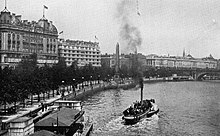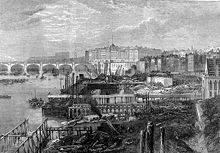Thames Embankment
The Thames Embankment is a major engineering feat of civil engineering in the 19th century to reclaim marshland on the Thames in central London. It is located on the north bank of the river and consists of the Victoria and Chelsea Embankments.
There is a long history of failed proposals to embank the Thames in central London. Embankments along the Thames were first suggested by Christopher Wren in the 1660s and by a former soldier and advisor to George IV in 1824. Sir Frederick Trench proposed a causeway known as Trench's Terrace from the boroughs of Blackfriars to Charing Cross. Trench introduced a bill to this effect in Parliament, which was blocked. In the 1830s, the painter John Martin campaigned for a causeway with a sewer underneath. The Municipal Works adapted a plan by James Walker in January 1842, but this came into conflict with internal government disputes. In 1854 the government built the Chelsea Embankment from the Royal Hospital Chelsea to Millbank.
In 1862 Sir Joseph Bazalgette began to design the present structure on the north bank of the river. The design took into account the main drains of the West London sewerage system and subway tracks, over which a wide road and footpaths were constructed. A retaining wall was built along the Thames. In total, Bazalgette wrested some 8.9 hectares of land from the river.
Much of the granite required for the construction came from Lamorna Cove in Cornwall. The quarried stones were hewn into blocks on site before being transported to the construction site on barges across the English Channel and the Thames.
Starting at Battersea Bridge in the west, the Thames Embankment includes parts of Cheyne Walk, Chelsea Embankment, Grosvenor Road, Millbank and Victoria Tower Gardens. After the Palace of Westminster, the structure and road are called Victoria Embankment, it ends at Blackfriars Bridge. Underneath this piece is part of the Underground network, used by the District and Circle lines. It passes Shell Mex House and the Savoy Hotel. On the Thames Embankment there are many parks and green areas, the Embankment Gardens, an oasis of peace in the middle of the city centre. There are many statues in the parks, including one of Bazalgette.
The much smaller Albert Embankment is opposite Millbank on the south bank of the river. It was built between July 1866 and November 1869 by Bazalgette for the Metropolitan Board of Works (MBW). A London-only coal tax, which went to the MBW, helped fund its construction.
Some parts of the Embankment date from the 20th century and were rebuilt after natural disasters such as the Thames Flood of 1928 or after damage from bombs in World War II.

The Embankment at the level of the former Hotel Cecil around 1910

The Victoria Embankment under construction (1865)
Search within the encyclopedia